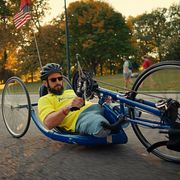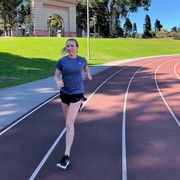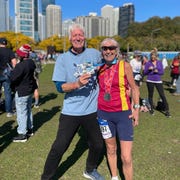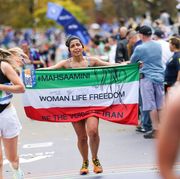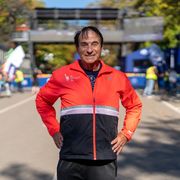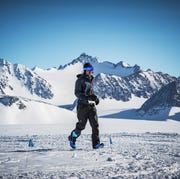In his first official 100-miler, Sania Sorokin broke the 100-mile world record, covering the distance in 11:14:56 on April 26 at the Centurion Running Track 100 Mile in Ashford, England.
It’s safe to say—his first attempt at the distance went pretty well.
The 39-year-old Lithuanian’s time bested the previous mark—11:19:13 set by American Zach Bitter in August 2019—by nearly five minutes. Sorokin’s average pace was 6:45 per mile.
More From Runner's World

Additionally, after setting the 100-mile record, Sorokin continued to run for an additional 45 minutes to chase the 12-hour distance record. He covered 105.825 miles (170.309K), breaking the previous record of 104.8 miles, also held by Bitter, by a mile.
Sorokin has run distances shorter and longer than 100 miles before, but he had never specifically run the 100-mile distance before. Rather, he’s spent his nine years of running focused on 100Ks and 24-hour races; he was the 24-hour world champion in 2019, winning with 172 miles at the IAU World Championships. He also won the 2017 Spartathlon in Greece.
That’s a pretty impressive resume for someone who just started running a decade ago.
Sorokin grew up as a competitive kayaker before getting injured and turning to alcohol, cigarettes, and lots of food. His weight crept up to 220 pounds, and before long, he had had enough, so he started running.
“Once I saw a piece of paper on the ground, an invitation to [participate in] a 100K,” Sorokin told Runner’s World. “I decided it was a challenge for myself. I decided to run 100K, and from there my story began.”
Running a 100-miler has been on Sorokin’s list for years. He initially wanted to run this race in 2020, but it was canceled because of the pandemic. As a dealer at a casino who works three days a week, Sorokin spent most of his time during the pandemic running. When he lost his job in 2021, he devoted the entirety of his time training.
“I ran like a real professional runner,” Sorokin said. “Preparation for the competition took about five to six months. I wasn’t working, so all the time I was just running, eating, sleeping.”
→ Sign up for RW+ All Access for the latest running news, health tips, and gear reviews! 🏃♀️🏃♂️
His workouts included runs anywhere from 10K to 50K, adding up to about 74 to 161 miles a week. He also did speed work such as six to 10 by 1,000-meters or four to five by 2,000 to 5,000 meters.
Running Pace Calculator COVID-19 protocols that required a quarantine period and negative COVID-19 tests. Because he wasn’t allowed outside the week before the race, his host, Bryn Jones, set him up with a treadmill.
On race day, Sorokin flew out of the gate well ahead of record pace around the 400-meter track. He cruised through the first 60 miles wearing his Meet RW+ Members, Drew covers a variety of subjects for Nike Alphaflys before a slight pain set in and slowed him down a bit. Around mile 68, he decided to change into.
Throughout the race, he fueled using chocolates, chips, sandwiches, bananas, and oranges, and he drank soda, Maurten, PH, and Basica. After mile 80 or so, he only took in liquids because his stomach didn’t want solid food.
About 10 laps before Sorokin finished 100 miles, with the record in reach, his team handed him a paper, asking him if he wanted to continue running and go for the 12-hour world record since he’d have time remaining.
“At the beginning, my thoughts were, ‘No! Enough is enough! I’m tired! I do not want!’” Sorokin said. “But after some time, I thought, ‘If I do not tolerate these [extra] 45 minutes, I will regret [it] my whole life,’ and I ran on.”
Sorokin’s legs are feeling good a few days after setting the record, despite some inflammation. He said his next race won’t likely be until the International Association of Ultrarunners (IAU) 24-Hour Championships in Romania on October 2. He’ll start training for that soon, but before he gets there, he plans to relax for a bit.
“After the finish there was a feeling of euphoria and satisfaction,” Sorokin said. “I would like to say, nothing is impossible. A human has a lot of resources and reserves. Let’s cross the boundaries of the impossible and make them possible.”
Drew covers a variety of subjects for Runner’s World and Bicycling, and he specializes in writing and editing human interest pieces while also covering health, wellness, gear, and fitness for the brand. His work has previously been published in Men’s Health.


